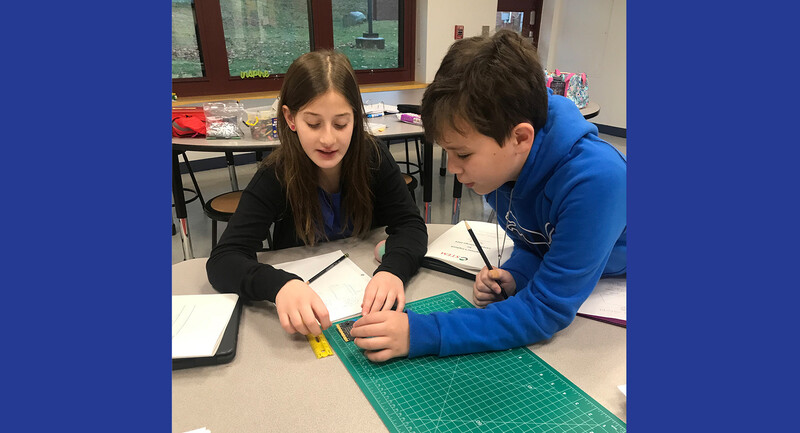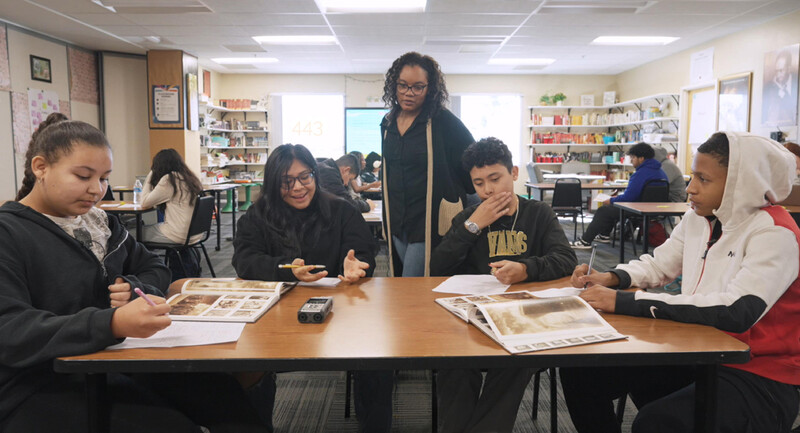The teen brain is a powerhouse of connectivity. Don't let the responses of "dunno" and "nothing" fool you. Behind teens' frequent evasiveness, there is a vast network of neurons constantly firing and creating pathways brighter than Times Square.
With each experience, teens are absorbing, interpreting, inferencing, filing, and archiving. But our goal as educators is to encourage creation, not just curation. That's where writing comes in. When a student writes—whether in a formal essay, exit card, daily journal entry, or constructed response—we are asking them to participate in an extremely rigorous method of creation. And writing of any kind is the assessment most often used in colleges and careers. It is, after all, "the primary basis for which work, learning, and intellect are judged by those in the workplace, school, and in the community" (Roman, 2018).
When it comes to the often difficult task of writing, however, the only way to coax a teen to accept such a challenge is by employing engagement strategies even as we focus on content. That's not to say that teachers have to do a tap dance to motivate students. But it means we have to help students connect with the material so that they want to engage with it. You see, a symptom of engagement can be a smile, but it can also be sweat.
There are many strategies we can use to encourage teens to want to write. One of the most effective methods we've employed at my school is to dial up the authenticity in assessments.
When "Meh" Is Not Enough
Each semester, I sit with my grade-level team to calibrate and score our 8th grade summative writing assessments. Calibration is a key practice to align our own opinions and also to learn strategies from colleagues while looking at student work. Calibration and scoring as a team help us combat subjectivity.
Earlier in my career, I anticipated these days with dread. We were highly regimented in our outlines and totally lock-step in our scaffolds. The 400 or so essays we reviewed might as well have been written by the same student. Sure, many students scored "proficient," but none of the essays made readers think.
We realized that our department had subscribed to the placebo of the five-paragraph essay as a means to help students meet a proficient standard of writing. We knew where it came from, of course. The five-paragraph outline was the result of an overly standardized system that's spanned decades, and our reaction to this systemic direction was to scaffold the process to such an intense degree that we had sapped creativity and risk taking from our students. As a profession, education has taken too much choice away from students in terms of how to write and, as a consequence, has created a genre of writing only replicated in schools. This kind of over-scaffolding, for many students, might feel like driving a car at Disneyland. You're moving forward, but you're on a track that doesn't let you steer or teach you to drive.
The teachers on my team eventually realized that "meh" was not enough when trying to teach students not only how to communicate with their writing, but how to make an impact with their written voice. So our team agreed to pilot some changes to fight against this grayscale method of teaching writing. The main goal was to be more intentionally authentic in our instruction and assessment design. We did that by upping our use of two engagement strategies: role-playing and student choice.
Ramping Up Role-Playing
Role-playing asks teens to pretend to be someone else, perhaps a member of a particular profession, and produce an artifact that mimics one that exists in the world beyond school. Because the five-paragraph essay is so inauthentic, we wanted to help students use their imagination to apply what they learned to more authentic tasks.
For me, the first step was to identify the kinds of writing that various professions engage in. So in the spirit of aligning my own writing instruction with the need for greater authenticity, I reached out to people via social media to see what kinds of writing their fields require. Among the examples I curated: university marketing brochures, U.S. Forest Service environmental analyses, medical reports, promotional posters, materials for online help centers, real estate contracts, lawyers' opening and closing statements, how-to guides, and even emails.
From there, I examined the elements of writing that each of these examples featured and, based on my analysis, developed a list of the most common elements:
1. Text structures and multimodal forms of evidence: Several of these pieces included subheadings; bullets; numbering; bold and regular font; and embedded tables, images, and videos. They also required the use of basic tech skills, ones that my students would need to master, such as taking screenshots, captioning images, selecting and summarizing video resources, and hyperlinking.
2. A variety of paragraph lengths: Often, we require students to write a strict structure of sentences in order for them to qualify as a paragraph. But in the workforce, professionals might use a single sentence embedded between two paragraphs to "punch" a point home or someone might have a—gasp!—three-sentence paragraph that fully summarizes a point. The key here is that these are intentional decisions, and teens are capable of making these choices.
3. Writing organized by purpose: Years ago, I stopped telling students they needed to write a certain number of paragraphs and instead shifted my language to "sections." I ended up with more interesting writing because often the resulting "introduction" wasn't just a single paragraph; it became a richer, multiple-paragraph section that provided deeper context to the essay. The "evidence" section, too, became more textured, with a combination of prose, images with captions, links to videos, as well as textual evidence.
4. Blending of genres: In real-world writing, you often see elements of different genres used within an essay to achieve the overarching purpose. For instance, a writer might use storytelling techniques to set the scene for an argument, tapping into narrative strategies before launching into an informative pitch.
5. Academic language specific to the content area: Each of the examples reflected their profession through the use of industry-specific terminology. I realized that if I wanted students to mimic more academic writing, I needed to encourage key word choice from them as well. If writing a mock U.S. Forestry Service white paper, for example, we could collectively create a word list based on research that might include terms like sustainability, conservation, or management. This would not only help with the authenticity of the "costume," but also provide an opportunity for cross-curricular content.
6. Data and statistics: Many examples of professional writing that I examined included numbers. In other words, we can't just use text to persuade an audience; we need to use data as well. As a result, I began teaching a series of mini-lessons that helped students learn how to support their argument with data.
In light of what I learned from this exercise, I started morphing my formal and informal written assessments. For instance, rather than have my students write an informational essay on the teenage brain, I had them role-play as a doctor diagnosing a teenager who showed signs of learned helplessness. They had to produce both a mock medical report and a less formal cover letter for the parents of that student, encouraging them with facts and data supporting neuroplasticity and debunking the myth of the static IQ.
In other words, in addition to my typical writing lessons covering conventions, sentence structure, stating a claim, citing evidence, and so on, role-playing added layers of expectations. The structure of the cover letter, for example, resembled an executive summary and included three sections: background, evidence, and recommendations. Students were asked to demonstrate their research and argumentative writing skills, ability to summarize, and strategic use of data.
The Choice Equation
Another way to tap into authenticity is to allow students more choice in the writing process so that they can test their own brain as a change-making muscle. As author and educator Alfie Kohn says, "The way a child learns how to make decisions is by making decisions, not by following directions" (1993). Therefore, in order to help train a teen's brain to make good academic choices, we must grant them the freedom to do so.
Choice gives students agency in their learning. Choice can even help students determine which assignments are most valuable to them personally. Robert Marzano reminds us that "When given choice by teachers, students perceive classroom activities as more important" (Marzano & Pickering, 2010). Writing plays an important role in helping students understand the power of their choices, because with writing, they can make a lasting impact on this world.
As a national faculty member for PBLWorks (formally The Buck Institute for Education), an organization dedicated to project-based learning, I see authenticity as the heart of engagement. PBLWorks has choice baked into its rubrics for determining what high-quality project-based learning (PBL) looks like. The organization promotes the belief that choice + agency = learning. By the same logic, teen writers need choice throughout the writing process—and in the ways they demonstrate their understanding—to learn their craft more effectively. We might offer
Choice in prompt.
Choice to use, or not use, an outline or graphic organizer.
Choice in what resources to pull from.
Choice in the structure of the essay itself (a speech? a website? a script?).
At the same time, it is important to note that we shouldn't give students the run of every decision all the time. Research has found diminishing returns when students have too many choices. Giving more than five options, for instance, has been found to produce less benefit than offering just three to five (Patall, Cooper, & Robinson, 2008). What works in my classroom is giving students choice in one element—say, a choice of prompts—but not in the genre they are writing in. Or I might give them a limited list of choices in what resources to use, but much more choice in how they want to show me their content knowledge. As long as I walk away with a formal or informal assessment of their writing ability and content knowledge, I feel comfortable mixing it up from assignment to assignment. The key is to offer choice when you can.
"Listen to This Line!"
Remember our "meh" written assessments? Well, once my department began developing more authentic assessments, ones steeped in role-play and choice, we began to see higher levels of engagement. And with increased engagement came results.
One assessment our team designed, for example, had students focus on being astronauts who landed off-course on the surface of Mars. Students first had to discuss in groups the tools and equipment they needed to traverse the surface of Mars in search of a beacon. They had to choose roles of expertise and which materials would be best suited for their survival. The resulting individual essays were a combination of narrative description of their plight and an argument persuading the group to follow their advice.
Another written assessment focused on the concept of de-extinction. The students role-played as teachers who had just completed a unit on Mary Shelley's Frankenstein (not coincidentally, our grade-level novel). As teachers, they needed to present a written lesson that gave the pros and cons of de-extinction based on a series of videos and articles that they could choose from. Then, through writing, they had to encourage their "students" to connect the ethical themes and scientific concepts from the resources to the novel the class had just completed. Rather than insist that they use an impartial voice in their writing, we allowed them to adopt a more enthusiastic voice, much like a teacher would ramp up his or her own energy when excited about a lesson.
Since making these shifts in our instructional design, the writing that students have submitted has been unique and full of voice. This approach elicited more creativity, and as a result, a higher quantity of writing. With more to assess, especially from reluctant writers, we could design an especially informed course of action, choosing the right tools to help each student improve.
Of course, the students who struggled with conventions continued to do so; after all, authenticity isn't a silver bullet for the struggles of every writer. But all our writers were coming to the table and trying. They were engaged, and the writing itself was enjoyable to read and made readers actually think. Students brought original thinking to their commentary rather than just translating textual evidence. Their conclusions communicated a purpose rather than just restating a thesis or claim.
Now, when our team is calibrating and scoring essays each semester, there are very different callouts happening in the room:
"Who has this awesome student?"
"This is so funny!"
"Oh my gosh. Listen to this line!"
We have to remember that the purpose of writing is to communicate effectively in the world beyond school. If we're falling asleep as readers, it's possible that our students are falling asleep as writers. By leveraging authenticity, however, with role-play and choice, we just might engage teens in new ways—and trigger a greater awareness that their voices can make an impact on this world.









